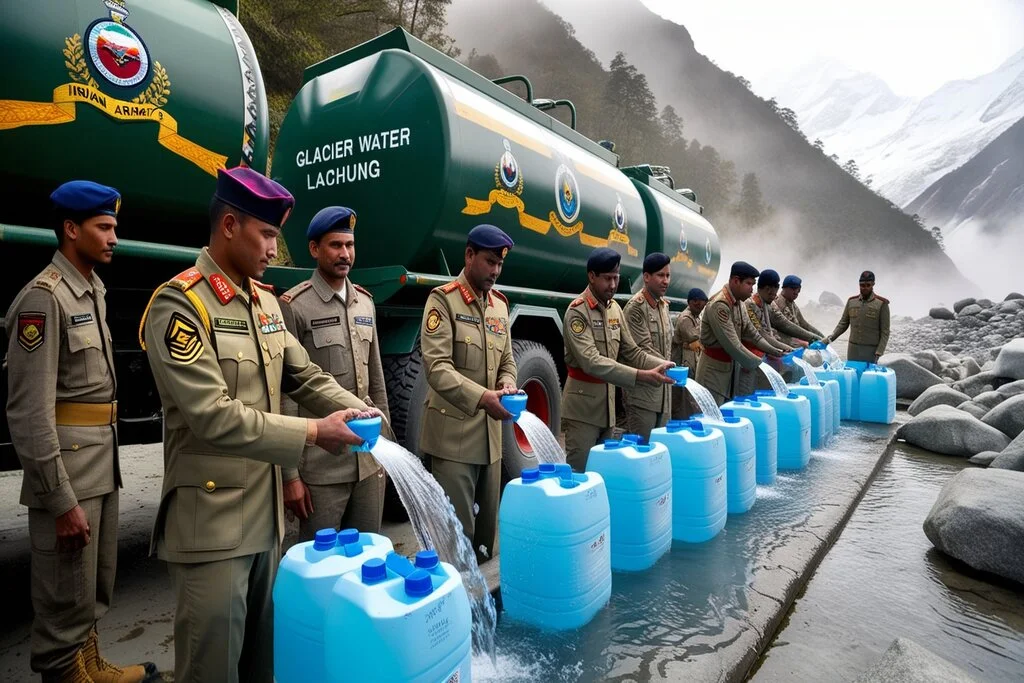On October 4, 2023, a catastrophic flood ripped through the remote town of Lachung in North Sikkim. A glacial lake outburst at South Lhonak Lake sent torrents of water crashing down the mountains, destroying roads, bridges, and homes. Over 1,700 tourists—including 63 foreign nationals—were stranded without food, shelter, or clean water. The Indian Army’s Trishakti Corps sprang into action, launching one of the most critical rescue missions in the region’s history.
But beyond evacuations and food drops, their most vital intervention was a heavy-duty water filtration system that provided thousands with safe drinking water. In a disaster zone where contaminated water could have led to deadly disease outbreaks, this single act saved lives and helped preserve Sikkim’s fragile tourism economy.
Lachung: A Paradise Under Threat
Sikkim’s Perfect Storm
Sikkim is a land of breathtaking beauty—glaciers, alpine meadows, and pristine rivers. But its geography makes it vulnerable. The state has over 300 glacial lakes, with at least 20 considered high-risk. South Lhonak Lake, the source of the 2023 flood, had been expanding for years due to melting glaciers. When it burst, the results were devastating.
Lachung, a popular tourist hub at 10,000 feet, was among the worst-hit areas. Roads were washed away, cutting off access to essential supplies. With local water sources contaminated by flood debris, the risk of waterborne diseases like cholera and typhoid soared.
Tourism: Sikkim’s Lifeline
Tourism accounts for nearly 8% of Sikkim’s GDP. Lachung, known for its stunning Yumthang Valley treks, is a key destination. Before the floods, the town welcomed thousands of visitors yearly. However, the region’s economic future hung in the balance with infrastructure destroyed and water unsafe.
The Indian Army’s Lifeline: Clean Water
Operation Trishakti Corps
Within hours of the disaster, the Indian Army launched relief operations. Helicopters airlifted stranded tourists to safety while medical teams treated injuries. But the most pressing need was clean water.
The Army deployed a military-grade water filtration system that purifies thousands of litres daily. While exact technical details remain classified, similar systems used by the Army typically employ reverse osmosis and UV sterilisation—technologies that remove bacteria, viruses, and heavy metals.
Why Water Was the Real Rescue
- Disease Prevention: Contaminated water can spread illnesses like dysentery within days. An outbreak could have been deadly in remote Lachung, where hospitals were already overwhelmed.
- Tourist Confidence: Without safe water, hotels and restaurants couldn’t operate. The Army’s system ensured that stranded and future visitors could access clean drinking water.
- Long-Term Stability: Unlike bottled water (which creates plastic waste), the filtration system offered a sustainable solution for locals rebuilding their lives.
The Technology Behind the Rescue
Military water purifiers are designed for extreme conditions—high altitudes, disaster zones, and war fronts. The system in Lachung likely included:
- Multi-Stage Filtration: Removing sediment, chemicals, and pathogens.
- Portability: Easy transport via helicopter or truck.
- Scalability: Capable of serving entire communities, not just soldiers.
Similar systems have been used in other disaster responses, like the 2015 Nepal earthquake. But the stakes were higher in Sikkim—floodwaters carried mud, industrial pollutants, and sewage.
Voices from the Flood
Tourists: From Panic to Relief
“We were trapped for three days with no way out,” said Ramesh Kumar, a tourist from Delhi. “When the Army brought in clean water, it wasn’t just about survival—it gave us hope.”
Foreign nationals, including European trekkers, were among those rescued. Many later praised the Army’s efficiency in preventing a health crisis.
Locals: Rebuilding with Water Security
For Lachung’s residents, the filtration system wasn’t just a temporary fix. With natural springs drying up due to climate change, reliable water access remains challenging. The Army’s intervention provided a blueprint for future resilience.
Lessons for a Disaster-Prone World
A Model for Future Crises
Sikkim’s floods won’t be the last climate-driven disaster. But the Indian Army’s response offers a template:
- Immediate Relief: Evacuations and medical aid.
- Essential Infrastructure: Clean water is a priority.
- Sustainability: Solutions that outlast the crisis.
Policy Changes on the Horizon
MP Indra Hang Subba has since called for increased funding to monitor glacial lakes. Meanwhile, Sikkim’s Comprehensive Water Resources Plan aims to address long-term shortages.
Conclusion: More Than Just a Rescue
The Indian Army’s water filtration system did more than save lives—it saved a way of life. For Sikkim’s tourists, it meant safe passage home. For locals, it meant a fighting chance to rebuild. And for the world, it proved that clean water isn’t a luxury in the face of disaster—it’s the first step to recovery.










